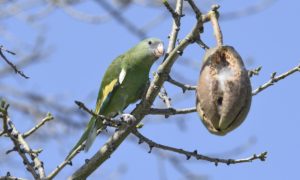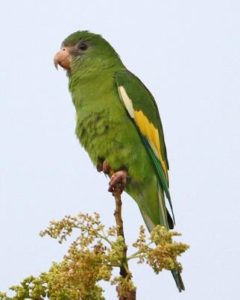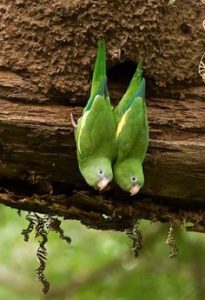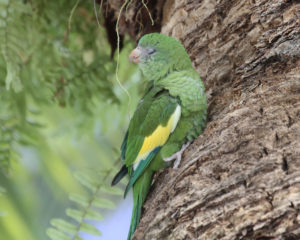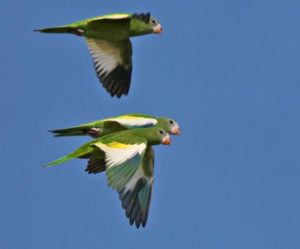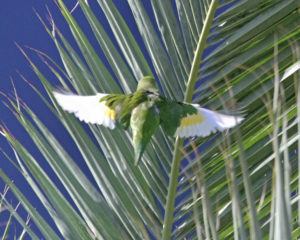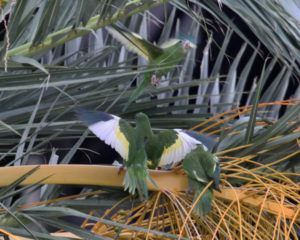White-winged parakeet, scientifically known as Brotogeris versicolurus, is a small invasive parrot widespread throughout the Amazon basin. It makes a wonderful pet due to its agile and jovial deportment. If you want an entertaining pet, this is the one for you. But before adopting one, you might want to be informed about the pros and cons of keeping a white-winged parakeet.
Quick Information |
|
| Other Name | Canary-Winged Parakeets |
| Color | Green body with yellow and white patches in folded wings.
The white part is mostly observed during flight. |
| Size | 8-10 in (20.32-25.4 cm) |
| Weight | 2.2-2.6 oz (65-75 g) |
| Distribution | Throughout southeast Columbia, Brazil, Paraguay, eastern Peru, Northern Argentina and Bolivia |
| Habitat | River islands, open forests, and savannahs |
| Diet | Fruit, flowers, and seeds |
| Breeding age | 2-3 years |
| Clutch Size | 3-5 eggs |
| Incubation period | Around 26 days |
| Fledging | 6-7 weeks |
| Lifespan | 10-15 years |
| IUCN Conservation Status | Least Concern |
| Temperament as pets | Active and playful |
| Maintenance requirements | It needs to be supervised frequently |
| Noise level | Fair |
| Talking ability | Average talkers |
As Pets
Housing
Set up either a stainless steel or a powder coated metal cage sizing 24X24X24 inches with a bar spacing ranging from ¾ – ½inch. Multiple perches inside the cage will help the parrot in exercising its legs. The cage should be placed in a clean area with enough natural light and air but away from draft. If you can keep it (the cage) against a wall, the bird would feel secure. If possible, have a playpen once your pet is tamed.
Temperature
A white-winged parakeet stays well at temperatures between 50°F-80°F.
Behavior
These parrots are great chewers and spend time with foraging toys inside the cage. They also love to stay out of the cage with their owners for a few hours each day. Being inquisitive by nature, they are inclined towards new objects which sometimes cause trouble, and they end up hurting themselves. Since in the wild they love to stay in flocks, domesticated parrots can stay with other similar birds as well. Only a few can talk, and not all are blessed with this ability, but those who cannot, will certainly keep you entertained by emitting shrill sound and frequent whistles. Some birds bond with only one person from a family, while others are not so fussy about it.
Feeding
Fresh fruits, vegetables, grains, and a pelleted diet are best for a white-winged parakeet. Some treats like cooked beans, chicken or egg are also good once in a while. A mineral block or a cuttlebone will be useful enough to prevent calcium deficiency. Never provide stale or rotten foods to your pet.
Care
These birds enjoy bathing so if you have a great bond with your feathered friend, you can let it accompany you to shower. If not, place a bird bath twice a week. Mist spray is another useful way to make it bathe.
Trimming of nails and clipping of wings are required by professionals once in a while.
You must thoroughly clean the cage with a mixture of dishwashing liquid/vinegar/ bleach and water once in every month. Also, don’t forget to scrub and clean the toys, food and water bowls of your pet.
Health Problems
A white-winged parakeet can suffer from psittacosis, bacterial hepatitis, avian tuberculosis, and avian gout. Also, runny nose and nasal discharge, beak swelling, fluffy feathers, feather plucking, loss of appetite, and changing colors of stools are symptoms of a possibly ailing bird.
Price
These parrots cost between $125 to $325.
Interesting Fact
- Before 1997, the name canary-winged parakeet was used to describe both the white-winged parakeet and the yellow-chevroned parakeet. But later on, the name became exclusive only to the white-winged parakeet.
Video: White-Winged Parakeet Playing Peek-A-Boo
References


